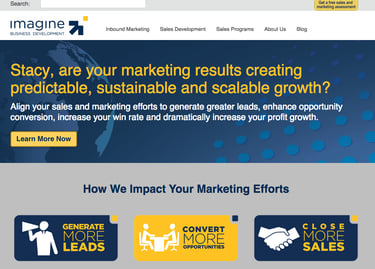 Over the last several years, the buyer’s journey has changed. The internet has given buyers the power to shop, research and learn in an entirely new way. They have the ability to navigate their way almost completely through many complicated B2B buying processes without talking to a live person.
Over the last several years, the buyer’s journey has changed. The internet has given buyers the power to shop, research and learn in an entirely new way. They have the ability to navigate their way almost completely through many complicated B2B buying processes without talking to a live person.
This shift has made sales and marketing alignment a key element in the predictable, sustainable and scalable growth equation. Websites are at the center of this new universe. Marketers need to create sites that essentially act as an on-call sales rep…someone who is there 24/7/365 to walk a prospect through their buyer’s journey.
Earlier this year, I wrote a post about how to attract the right traffic to your website. Today’s post will take it one step further. Attracting visitors is only half the battle. The other half is converting those visitors into known leads.
Conversion Rate Optimization
Conversion is simply measuring how many website visitors take the action you want them to take when visiting your site. That action can be subscribing to your blog, downloading content, making a purchase or creating a password. At Imagine, when a visitor downloads a piece of content or subscribes to our blog, they become a lead. They have converted from an unknown visitor to a known lead.
To calculate conversion rate, simply divide the number of total conversions by the total number of visitors to your site. For example, the conversion rate for a site with 3,000 monthly visitors and 30 conversions is 1%.
Conversion Rate Optimization or CRO is the process of creating an experience for your website visitors that will motivate them to take the action you want them to take. Conversions take place all over your website. Your homepage, landing pages, inside pages, blog posts…everywhere. Every opportunity for conversion can be optimized.
Four Ways to Optimize for Conversions
1. User experience
User experience or UX is more than just how your site looks to your visitors. It also includes how easy your site is to use, how fast it is and the amount of friction a user encounters when trying to do whatever it is they are there to do.
Users give up on a site for a variety of reasons. When you evaluate your user experience, look for wasted clicks, excess pages, false starts, bad links, slow page loads and anything else that will frustrate a user. Streamlining the path to conversion will result in more conversions.
Remember, the goal is not to convert every visitor…it is to convert the right visitors. Your buyer personas will help you determine who the right visitors are. Design your UX in a way that will move your personas through the process and to the experience they are looking for.
2. A/B testing
A/B testing (or split testing) is a common technique used to evaluate the effectiveness of a particular landing page, call to action, etc. The general idea is to create two versions of your page. They can be completely different or just a few elements can be different. Half of your visitors will see one version and the other half the other. After a determined amount of time, the page with more conversions (more people taking action) wins.
There are several elements that can be tested. They include:
- Headlines
- Calls-to-action
- Page navigation
- Overall page design
- Size and color of buttons and other graphics
Be careful not to try to test too many things at one time. Carefully designing your tests will lead to better data which will help you make better informed decisions. For more on A/B testing, read this guide from HubSpot.
3. Personalization
According to HubSpot, email click through rates (CTR) are higher when using the recipients first name in the subject line over no use of the first name. And guess what? Using dynamic content that is specific to a website visitor drives more conversions.
Dynamic content lets you create a unique experience for each person who visits your website based on their interests, the pages they've viewed or offers they have clicked on in past visits.
At Imagine, we use HubSpot's Content Optimization System to create dynamic content. Because I have visited our site many times, the homepage now “greets” me when I come back.

We’re also using dynamic content for our calls-to-action. Personalized calls to action convert 42% more visitors than basic calls-to-action. If someone has visited our site and clicked on a specific call-to-action in the past, we show them a different one when they visit again.
4. Testimonials
Providing testimonials on your website can help drive conversions. Prospects like to see proof that your product or service actually works for people like them. Well-written testimonials that tell a story your buyer personas can relate to go a long way in providing the proof they’re looking for.
Case studies are also an effective way to demonstrate how your product or service has provided a solution. According to Demand Gen Report’s 2015 B2B Content Preferences Survey, the top 5 content formats that B2B buyers used in the last 12 months to research a purchase decision included: whitepapers, webinars, case studies, ebooks and videos. Additionally, when asked “What do you feel are the most valuable online content formats for researching B2B purchases?” respondents ranked case studies as the most effective.
Better website conversion rates will lead to more MQLs, more SQLs and eventually to more sales. Continuous testing and evaluation of your site is worth the time and effort.

